Another curious little surprise.
Posted by C Scheftic on 2011/05/25
I noticed something in my studio yesterday that, once I got over the surprise, did actually make sense in a way I hadn’t thought about before.
In several other posts, I’ve mentioned that I like making pieces where I weave together bits of metal clay that have been specially treated so that the resulting dried “greenware” remains flexible.
Well, I recently made several pieces using that technique applied to copper, bronze, and steel clays too. I’ll post about those pieces eventually, I’m sure, but it’s the leftover materials from those that are the focus of this post.
With silver metal clay, it’s fine to just leave lying about the dried greenware (whether it’s of the hard or the flexible variety). Dried pieces can just sit there waiting to be fired, and extra bits of dried but still flexible greenware can be left alone waiting to be used in some future project. (Leftover moist clay should be sealed up securely, so it remains moist for future use. Care should be taken with leftover moist clay to prevent it from becoming moldy, but that’s not my point here either….)
With copper and bronze clays, you can leave dried pieces around for a little while, waiting to be fired. Maybe not as long as with silver, since the outer layer will begin to oxidize (tarnish) eventually, but it’s not like you have to rush to get the stuff into the kiln. (Besides, since you can fire fewer of these pieces in a single load than you can with silver, it doesn’t take as long to accumulate a “full kiln load” as it does with silver … though sometimes it does take me a while to find the time to tend to the more complex firing schedules with these clays.) The same seems to be true of stuff that’s been treated to form flexible greenware. It will remain flexible and usable for some time, though not forever. Moist clay should be sealed up very tightly: in addition to preventing evaporation of the moisture in it, you also want to reduce any possible reactions from exposure to atmospheric oxygen and pollutants. Luckily, freezing of any of the moist or dried clays in this family seems to help reduce the oxidation that can form as a result of even limited exposure.
But steel, well, that’s a different beast. It doesn’t just tarnish, it can actually rust, so finished pieces require some extra treatments to help reduce that. But here’s the bit that surprised me when I first saw it, but not once I’d thought about it: specks of rust can form all over any pieces of flexible greenware that are left lying about! Even if it’s only been for a few days, the trick to flexible clay is that it never really dries out and, of course, damp steel will rust for sure….
Shown below are “left over” pieces of flexible greenware. In order, they are: copper, bronze, and now-rusty pearl gray steel. Sigh.
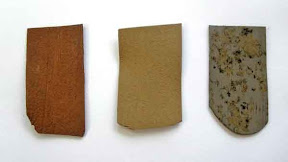
|
I guess I’ll have to try freezing any leftovers from the next batch I test out, to see how long that holds up.
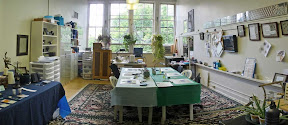
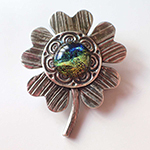 Artsmiths of Pittsburgh
Artsmiths of Pittsburgh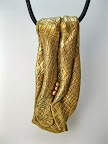 Hoyt Center for the Arts, New Castle, PA
Hoyt Center for the Arts, New Castle, PA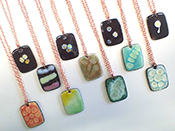 Portage Hill Gallery, Westfield, NY
Portage Hill Gallery, Westfield, NY _Open Houses in my Studio
_Open Houses in my Studio _Or…contact me about hosting a private party!
_Or…contact me about hosting a private party!
Alice Walkowski said
How do you like working with the steel? How is it comparable to working with the copper and the bronze.
LikeLike
C Scheftic said
Hi, Alice:
I find all of Hadar’s clays to be reasonably comparable to each other, and absolutely lovely to work with.
Having said that, I should clarify that I have not yet made any all-steel pieces because of the potential issue with rust. I have incorporated small amounts of the pearl gray steel into some pieces that used her “mokume gane effect” and some that involved weaving. That is, I’ve used the least-prone to rust version of the steel and still put it where it does have visual impact but is not essential to maintaining the structure of the piece….just in case.
At this point I am still working to understand the various “white color” options in these mixed-metal applications. Silver is pricey and involves a number of complications when fired with bronze. White bronze is fragile after firing (i.e., needs to be treated more like a glass element than a metal one…) and is the trickiest to fire anyway. Pearl gray steel ends up the darkest (of the ones I’ve tried) and has the potential rust-issue but, so far, has definitely been the easiest to mix in with copper and/or yellow bronze and yield a nice final product.
I do plan to eventually try some all-steel pieces (especially, living in Pittsburgh, how can one not at least try that…) but, with limited time, that just has not been a top priority. Also, with the conservative approach I’ve taken to mixing it all up and then tweaking it yet more to make the flex-greenware version, I haven’t yet managed to get any that was quite flexible enough to knot, so that’s something else to explore later on too.
Gosh, that’s starting to sound like a plan for a play-day, isn’t it (except the time involved is more like a play-week)!
-cs
LikeLike